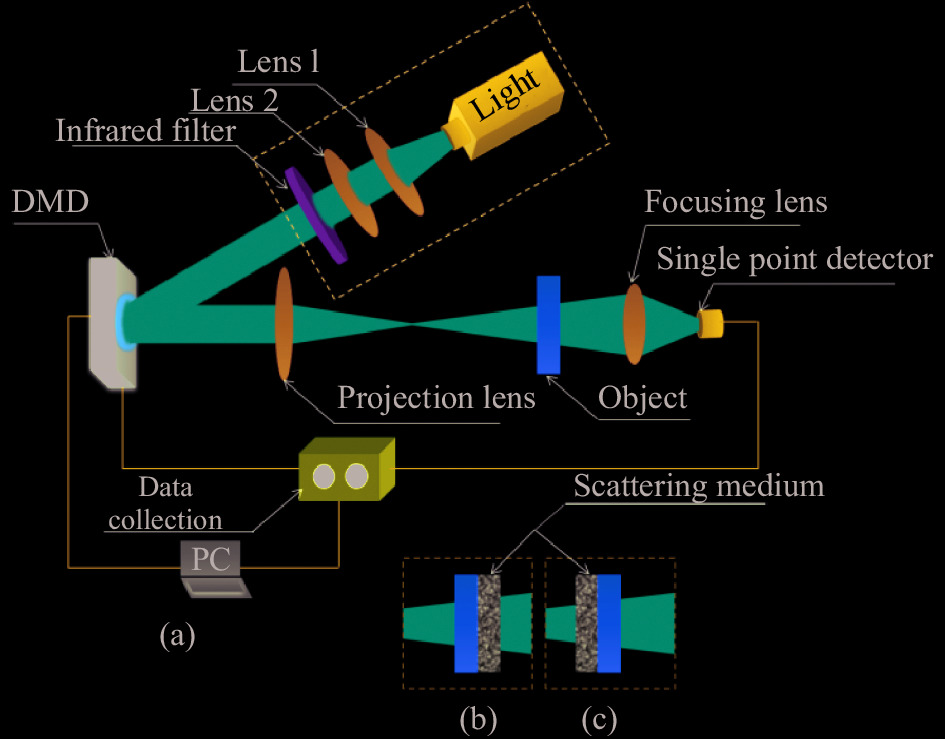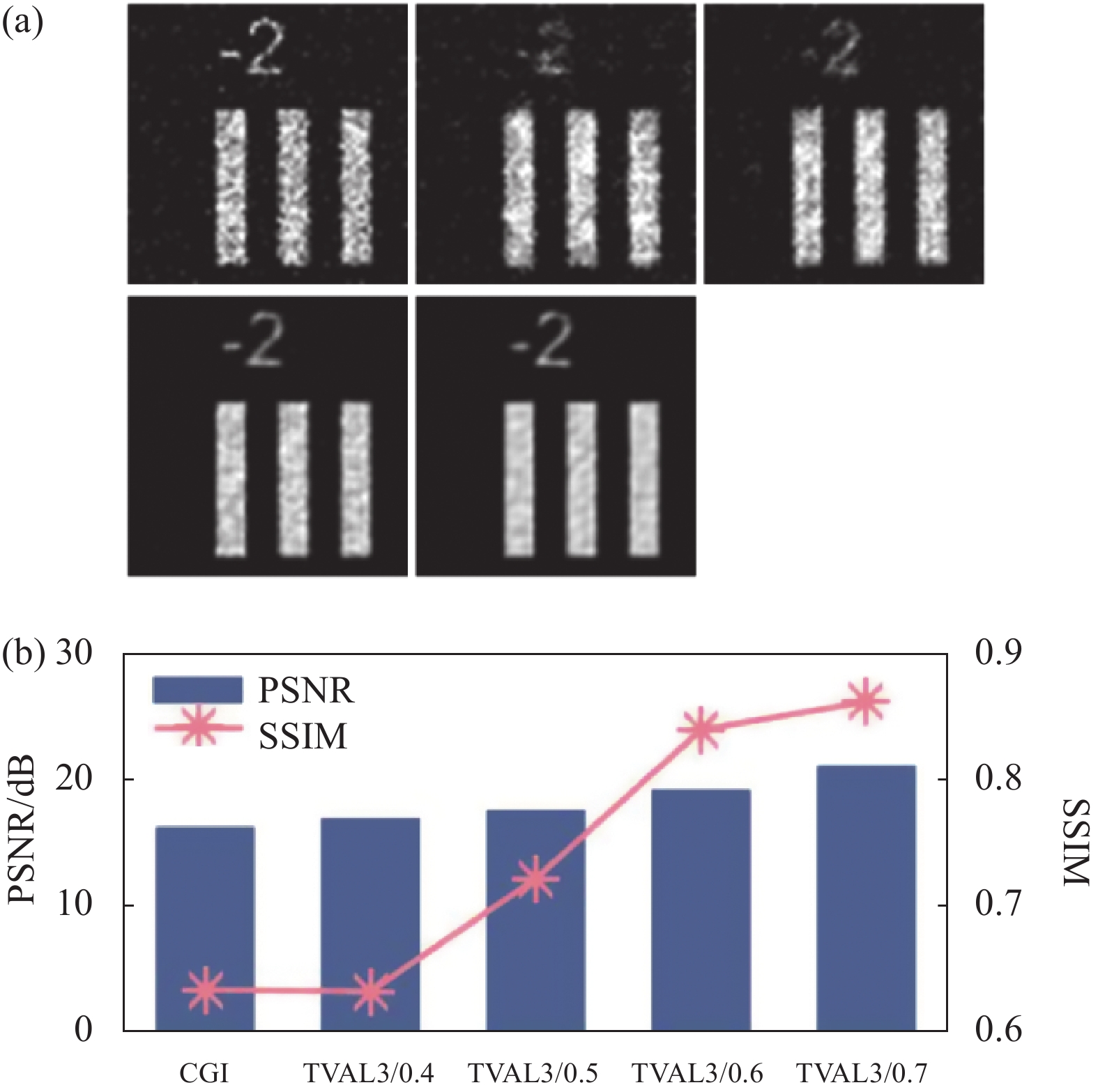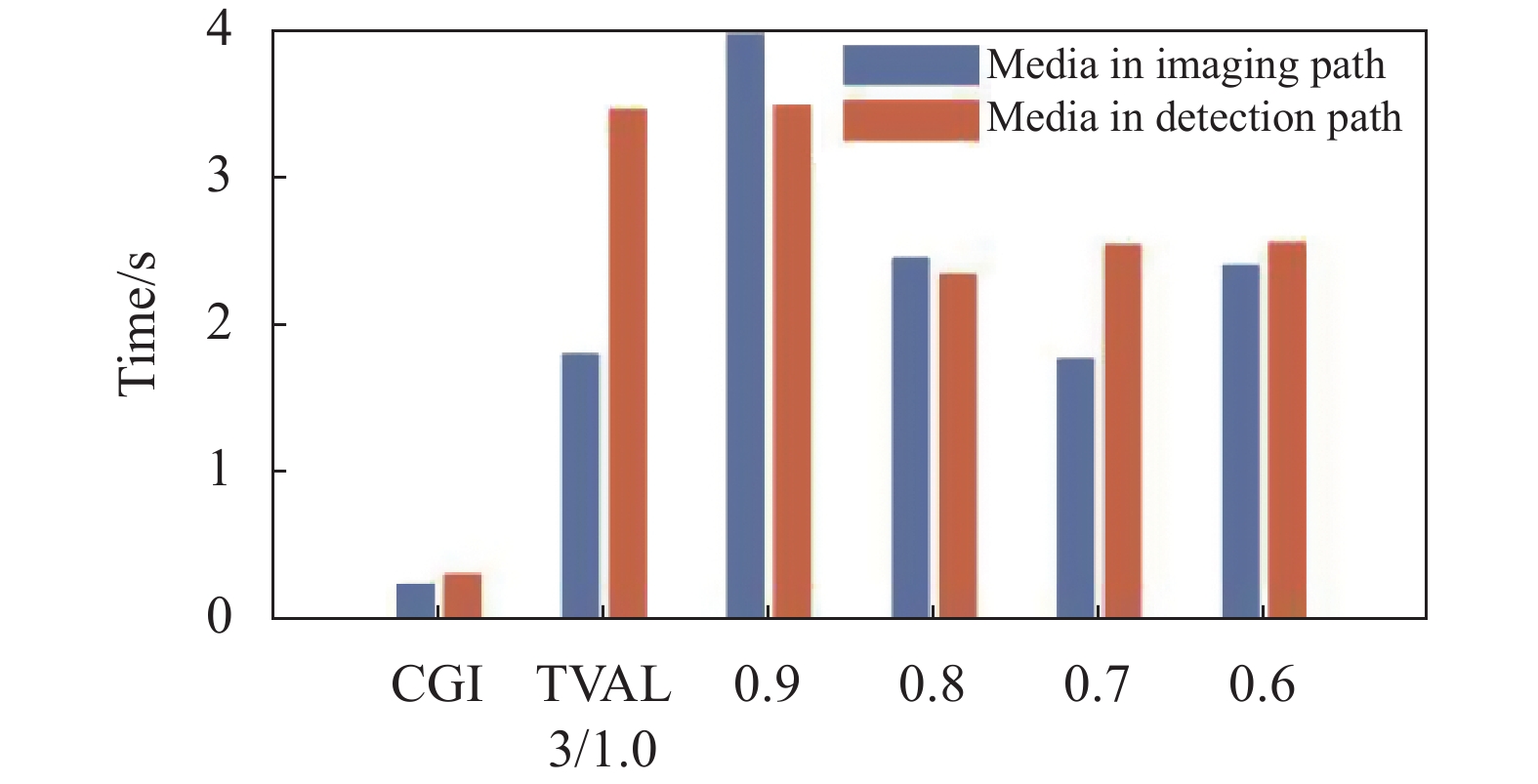-
单像素成像(SPI)是近年快速发展的新型计算成像技术,在扩展谱带、抗干扰能力和高灵敏度等方面具有独特的优势。如图1所示,单像素成像系统按功能可以分为五个部分:光源照明模块、编码光调制模块、同步模块、数据采集模块和图像计算重构模块。光源发出的光束在编码光调制模块中被调制[1],通过结构照明的方式对待成像物体进行采样,同时同步模块发出同步信号到单点探测器,这样探测器探测到的信号与变化的照明模式是相互对应的,记录的光强数据通过重构算法恢复出原始目标图像。
在单像素成像实验中,通常选用数字微镜阵列(DMD)作为空间光调制器(SLM)。单点探测器的选择较多,有光电二极管(PD)、光电倍增管(PMT)、单光子雪崩光电二极管(SPAD)等。单点探测器的一个优势是:在非可见波段下,成本比二维阵列探测器低[2];另一个特点是:无空间分辨能力,仅探测记录某个小范围区域内的光强值,因此对成像环境要求较低,抗噪能力较强,与光学元件配合可以收集到微弱的信号。基于这个优点,单像素成像技术可应用在生物光子学上[3],结合近红外波段的光源可以穿透皮肤、血管等生物组织,对人体内部组织结构进行成像[4],为医学诊断提供一种新方法。
重构算法是单像素成像的关键技术,主要分为两种:关联算法和压缩感知算法。
2011年,Gong W等人利用光场的二阶相关性实施了穿透散射介质的物体成像[5]。传统二阶关联算法计算参考光束的结构光空间分布和物光束的强度之间的二阶相关函数[6-7],可以很大程度上消减环境影响,在强吸收、弱散射介质下也可以稳定成像[8]。研究人员不断优化实验的装置、光路和算法,在计算鬼成像中,用测量矩阵代替参考光路,光路得到简化,其计算方法更加多样化。差分关联算法增加了一个对信号波动部分感兴趣的差分桶信号,显著提高了信噪比,使得鬼成像也可应用在一些对环境要求严格的成像问题上[9]。
2006年,Donoho D L等人提出压缩感知理论[10],利用原始信号的稀疏性,将得到的少量采样值进行处理,恢复出准确的原始信号。将压缩感知理论运用到单像素散射成像,不仅可以提高图像的信噪比,而且降低了采样时间[11]。匹配追踪算法复杂度低[12],局部匹配追踪算法可重构强散射介质下的目标图像,分辨率高、成像锐度好[13]。凸优化算法精度高、计算量大[14],可实现在动态散射介质下的单像素成像[15]。最小全变分法依靠图像的离散梯度处理图像中人眼敏感的区域[16],可以对隐藏在硅片下的物体进行单像素成像[17]。
文中针对单像素成像重构算法在受散射介质影响时表现不同,导致重构图像无法达到最佳效果的问题,提出了针对无散射介质和有散射介质的情况,利用近红外光源与生物组织散射介质,选择将散射介质分别紧贴于目标物体前后,采用关联算法和压缩感知算法进行实验并比较重构图像质量的方法,开展了CGI算法与TVAL3算法在两种情况下的成像质量研究。
-
文中分别选取了传统二阶关联算法(GI)、传统差分关联算法(DGI)、计算差分关联算法(CGI)、随机二值矩阵正交匹配追踪算法(OMP)、阿达玛矩阵正交匹配追踪算法和阿达玛矩阵全变分正则化算法(TVAL3)对模拟测量值信号进行重构,并且对比了不同采样率下的成像效果。GI算法通过调制光路上的总光强Si与参考光路上的光强分布Ii (x,y)来计算得到待成像物体TGI (x,y):
DGI算法在此基础上,将参考光路的光强分布做离散化求和处理。CGI算法对观测矩阵的选择性更多,通过DMD实现二值光场调制,提高了投影的对比度。OMP算法通过贪婪迭代找到观测矩阵中与当前残差相关性最好的一列,迭代剔除。TVAL3算法引入增广拉格朗日函数和交替方向变换,使用梯度下降法迭代求解[18]。
从图2和图3中可以看出,前两种算法得到的图像效果较差;CGI算法在全采样下,重构结果与原图几乎无差异,并且所需时间最短;OMP算法在采样率为0.3时可重构出图像的轮廓和部分细节,但所需时间最长;图3 (b)、(c)显示,TVAL3算法明显重构效果最优,采样率为0.1时就可以大致重构出图像的轮廓和细节特征,相似度为0.474,采样率为0.3时相似度可达0.773,并且计算速度比OMP算法快。

Figure 2. Reconstructed images under different algorithms. The algorithms used in (a)-(f) are the traditional second-order correlation algorithm, the traditional differential correlation algorithm, the calculated differential correlation algorithm, the random binary matrix OMP algorithm, the Hadamard matrix OMP algorithm and the Hadamard matrix TVAL3 algorithm, and the sampling rates are 0.1, 0.3, 0.6 and 1.0
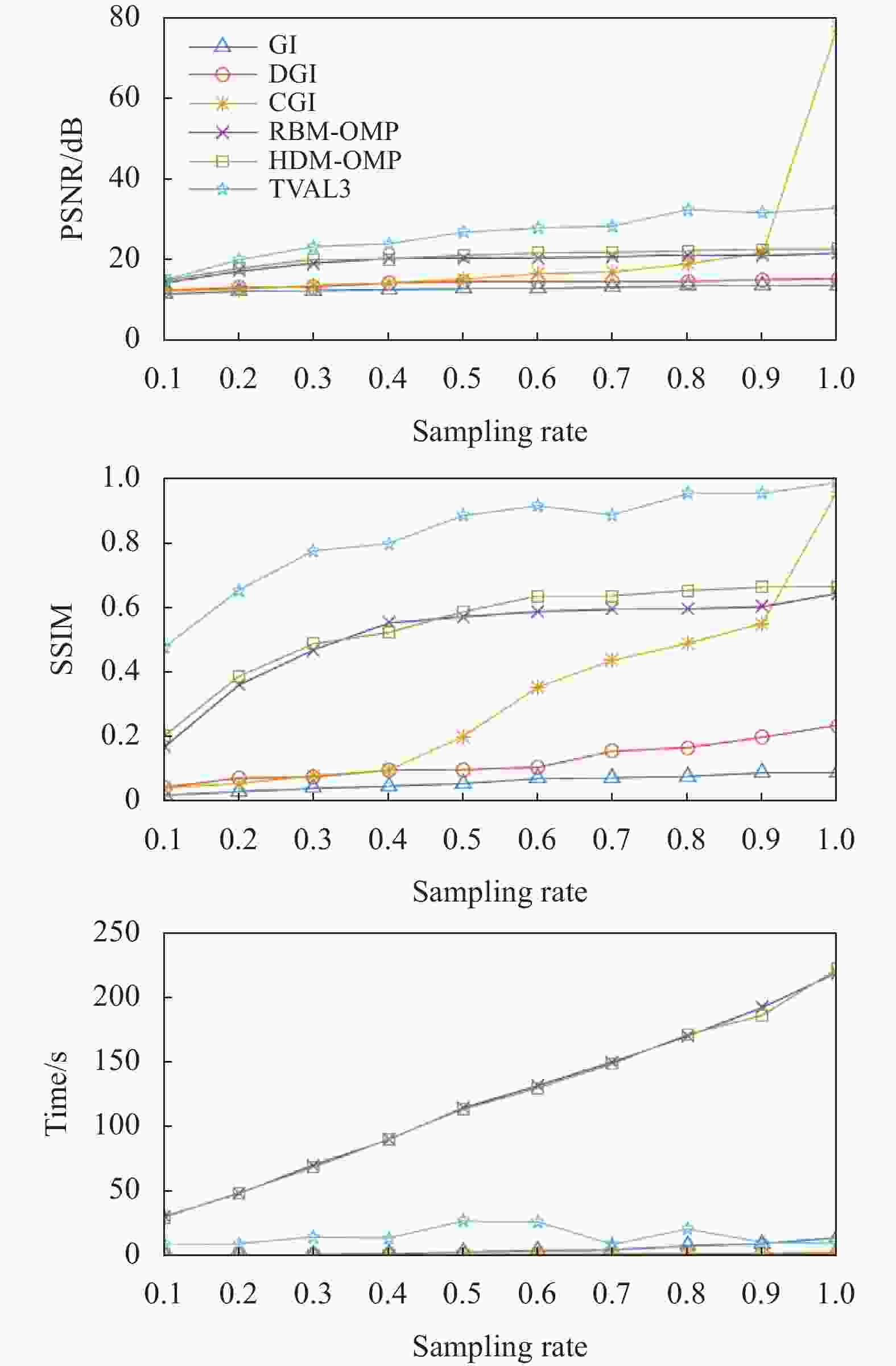
Figure 3. Image quality evaluation using different reconstruction algorithms at different sampling rates (PSNR, SSIM, TIME)
上述仿真模拟仅针对无散射介质时单像素成像重构算法的比较。在光路上放置散射介质后,携带调制信息的光束会改变传播方向以及被介质吸收[19],在目标平面形成一个散射光晕。在散射介质成像实验中,散射介质影响的不只是成像光路,还有目标到探测器的一段探测光路。差分关联计算主要计算调制信号与经过调制的目标信号之间的联系,可以削减成像光路信号变化带来的不利影响。而压缩感知的特点是通过稀疏约束以少量信号来恢复高精度的原始信号,与采样率关系较大,与被散射介质强散射性削弱的探测光路信号有一些相似性,作为重构算法可以抵消非成像光路上的不利影响。
-
以厚度1 mm的猪肉切片为散射介质,光源采用光纤卤钨灯和红外滤光片,对USAF-1951分辨率板进行成像,InGaAs探测器为单像素探测器进行信号采集,具体参数和光路如表1、图4所示。
Key device Parameter Light source Wave length: 260-2500 nm Lens 1 AR COATED 650-1050 nm, f=26 mm Lens 2 f=100 mm Infrared filter 800-2500 nm DMD Operating 350-2700 nm, 1024×768 pixel Projection lens f=35 mm Single point detector Operating 800-1750 nm Focusing lens AR COATED 650-1050 nm, f=60 mm Table 1. Key device parameters in the experiment

Figure 4. Layout of active single-pixel imaging system based on DMD. (a) When there is no scattering medium; (b) When the scattering medium in detection path; (c) When the scattering medium inimaging path
首先在无散射介质的情况下实施近红外单像素成像实验,采用分辨率为64×64的阿达玛矩阵,分别使用CGI算法和TVAL3算法在不同采样率下恢复。为了减少随机误差的影响,循环采集四次数据并取平均值作为实验结果的最终测量值。
CGI算法使用4096个测量值重构了目标图像,PSNR与SSIM分别为16.3051、0.6337。TVAL3算法在采样率为0.4时就可以重构出图像的轮廓和细节特征,PSNR与SSIM分别为16.9636、0.6326,如图5(b)所示,两种算法的重构效果相近。可以看出,在无散射介质时,基于压缩感知理论的TVAL3算法的成像质量优于基于关联成像理论的CGI算法。

Figure 5. Comparison of the reconstruction effects of the two algorithms with non-scattering medium. (a) The first image recovered by CGI, and the last four images are recovered by TVAL3, with a sampling rate of 0.4-0.7; (b) PSNR and SSIM comparison of reconstructed image
在图4所示的光路上加入散射介质后,介质的多重散射作用促使光束随机偏离原来的传播方向。成像光路上结构光的空间信息将被打乱[20-21],抵消了结构光照明可增加有效信息提取[22]的优势,造成成像质量下降。如图6 (a)、(b)所示,在结构光的传播路径上放置毛玻璃做散射介质。在d1距离处,光束经过毛玻璃后空间结构细节变得模糊,并且距离越远,图像越模糊,最终如图6 (b)所示,在d2距离处图像失去正方形形状,变成一个大的光斑。同样的,如果将散射介质放置在非成像光路中,光被混匀,可探测到的光束强度衰减。如图6(c)、(d)所示,均匀光经过物体和紧贴物体的毛玻璃后,光束的传播方向同样发生了变化,如同经过了一个光扩散板,并且随着距离变长,光束愈发扩散。

Figure 6. Performance of the light beam under the scattering of ground glass. (a)-(b) Intensity distribution comparison of structured light with or without scattering medium; (e) Uniform light passing through the object and scattering medium; The upper of (c1)-(c2) is a photo taken directly, and the below is a picture taken from the observation surface; (c3) Uniform light passing through the object and scattering medium; (d) Uniform light passing through the object
选择厚度约为1 mm的生物组织,分别固定在分辨率板的前面(图4 (c))与后面(图4 (b))。介质的散射作用会限制成像深度,使被介质包裹着的目标信号不容易被探测器接收到,并且探测到的微弱信号易与探测器噪声混杂。因此,在重构运算前,需要在测量值中减去无光和有光环境下探测器的暗噪声平均值。此外,在重复测量的数据中选择最大的数据作为测量值。经过预处理的测量值可以在一定限度内减小探测器噪声、环境光照、光源强度波动对测量值的影响。对于TVAL3算法,选取多个采样率进行图像重构并对比,调整了重构图像的灰度,增加非线性映射操作,增强了对比度。
图7的成像结果表明,生物组织散射介质对成像有一定程度的影响,重构图像质量下降。CGI算法得到的图像底噪多,其SSIM值略低于TVAL3算法,但PSNR值(10.1886、9.9831)均高于TVAL3算法重构图像的PSNR(9.170456)。当TVAL3算法的采样率减小时,图像结构越发不明显。

Figure 7. Reconstructed image of penetrating scattering medium. (a) When the medium in imaging path, using CGI algorithm and TVAL3 algorithm, the latter sampling rate is 1-0.6, its peak signal-to-noise ratio and similarity. Comparison of (a) is in (b); (c) When scattering medium in detection path, and the comparison is in (d)
当涉及到动态成像时,单像素成像对成像时间也有要求。实验选用了高速切换状态的DMD对光束进行编码[23],其照明时间与探测器的响应时间相对应,因此不同场景下的数据采集时间相同,在静态成像下对成像结果影响不大。图8为在有散射介质的情况下两种算法分别重构图像所需的时间,可以看出CGI算法所需的时间远小于TVAL3算法。
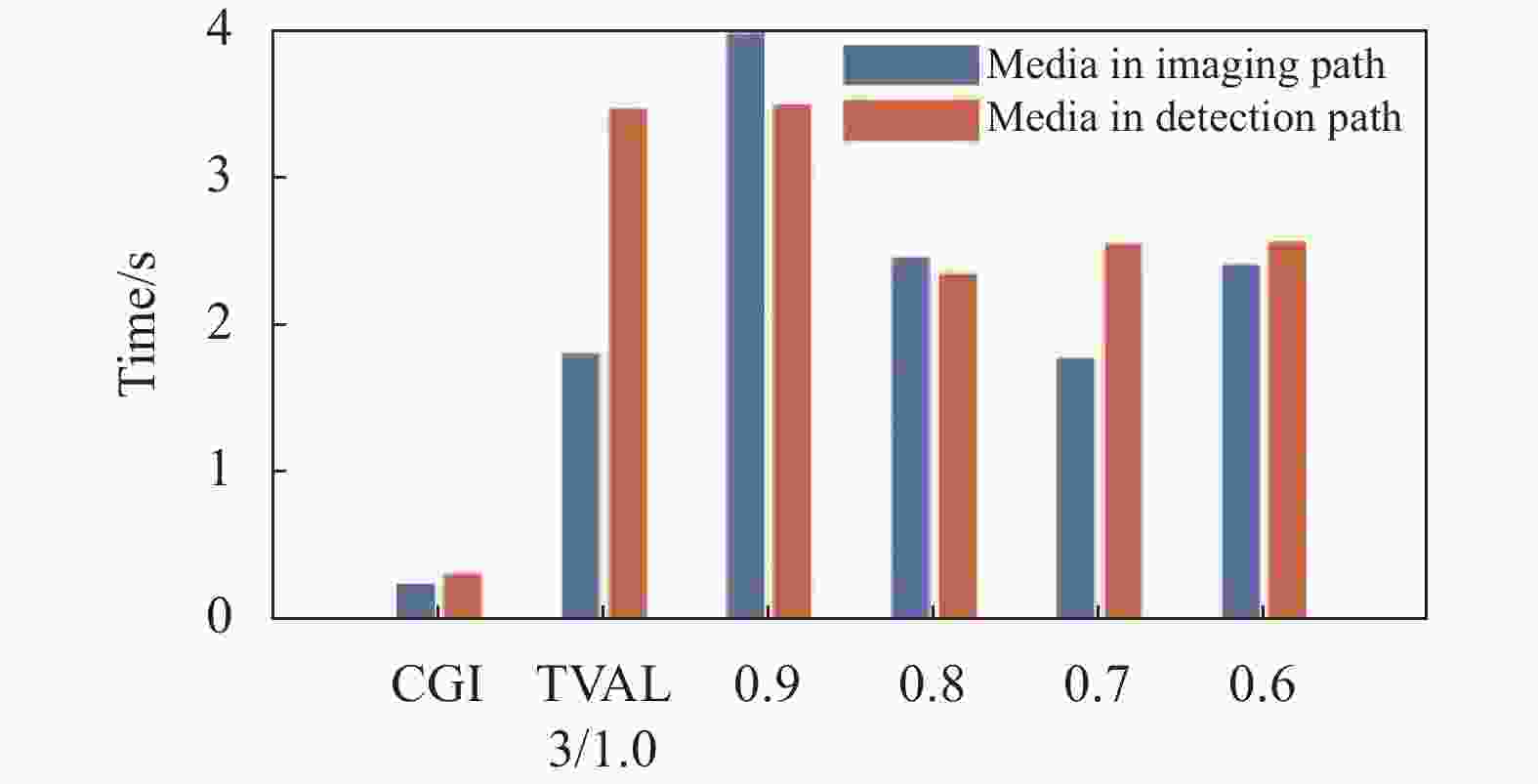
Figure 8. Comparison of reconstruction time between CGI algorithm and TVAL3 algorithm in penetrating scattering media imaging
从以上实验结果可以看出,在有散射介质的情况下,CGI算法重构的图像质量略优于欠采样率的TVAL3算法,而可压缩性正是压缩感知理论的特点,采样率越低时,基于压缩感知理论的重构算法优势逐渐降低。
-
设计搭建了基于近红外波段的单像素成像系统,并根据单点探测器只需探测光强变化的特点,将其应用于生物组织散射介质成像中。并且分析了调制光投影的成像光路与收集光强值的探测光路的特点,除去探测值中的探测器噪声,取多次测量值的最大值。分别进行了两种重构算法下的无散射介质和有散射介质成像,发现基于关联成像理论的CGI算法较适合散射介质成像,基于压缩感知理论的TVAL3算法更适合无散射介质成像。除此之外还有许多问题需要深入研究,如动态成像中探测器的积分时间等其他因素对单像素成像质量的影响,后续可以继续深入研究。
Scattering interference suppression for single-pixel imaging reconstruction of biological tissues
doi: 10.3788/IRLA20210722
- Received Date: 2021-09-30
- Rev Recd Date: 2021-12-06
- Publish Date: 2022-04-07
-
Key words:
- single-pixel imaging /
- scattering medium imaging /
- compressed sensing /
- correlation algorithm
Abstract: In view of the influence of the scattering medium in the reconstruction of single-pixel imaging, the reconstructed image cannot achieve the best effect. The applicability of the correlation algorithm and compressed sensing algorithm for image reconstruction with or without the scattering medium was investigated. The influence of the spatial structure change of modulated information in the imaging path and the signal loss in detection path caused by the medium was analyzed, a near-infrared single-pixel imaging system was established, and the single-pixel imaging of penetrating the biological tissues scattering medium with the CGI algorithm and the TVAL3 algorithm was realized. It was found that the reconstruction time, peak signal-to-noise ratio and SSIM of the TVAL3 were better than CGI when there was no medium; while two of the three values of the CGI were better when there was medium, its maximum reconstruction time (0.304091 s) was smaller than the minimum (1.766299 s) of the TVAL3, and its minimum PSNR (9.9831dB) was higher than the maximum (9.170456 dB) of the TVAL3, and its SSIM (0.0982,0.1178) lay within the range of the SSIM of the TVAL3 (0.099258-0.497622). The results show that the CGI based on correlation imaging theory is more suitable for imaging scattering media, and the TVAL3 based on compressed perception theory is more suitable for imaging non-scattering media.



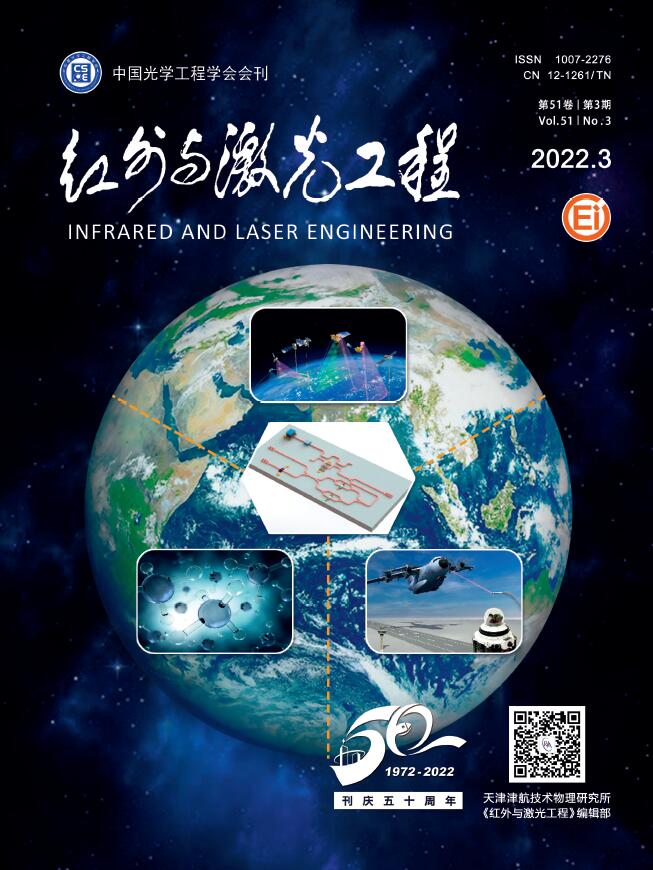


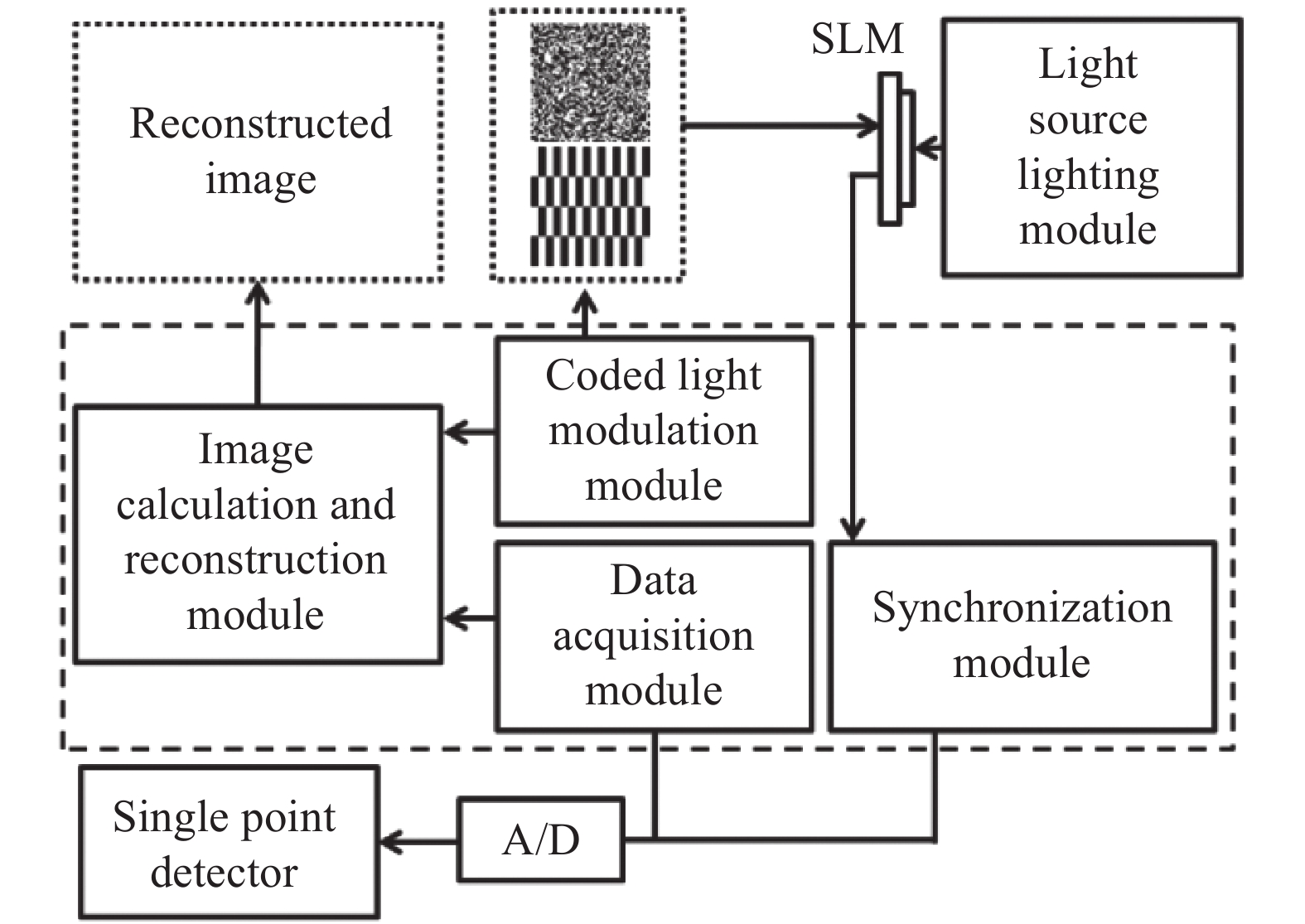


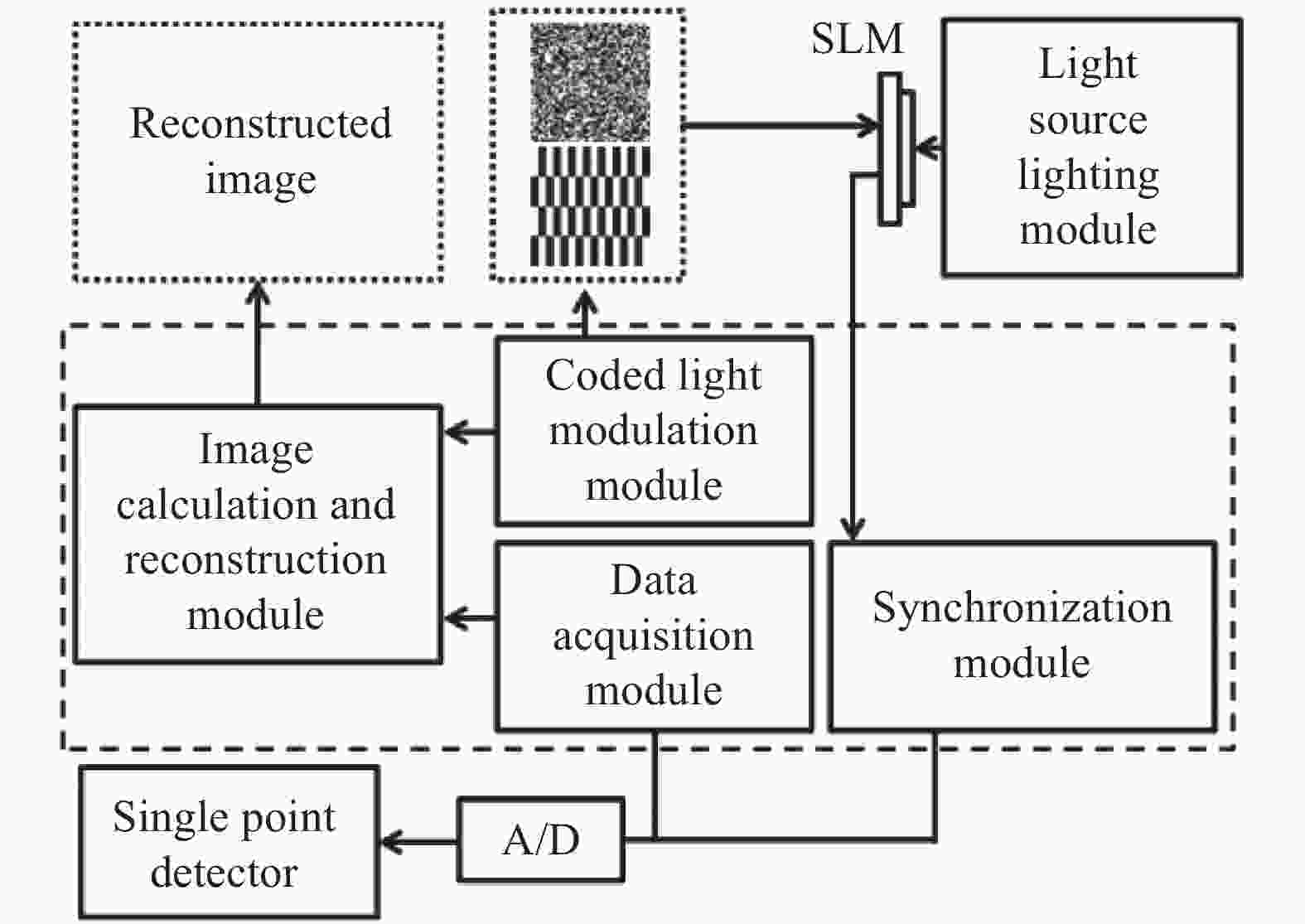

 DownLoad:
DownLoad:


